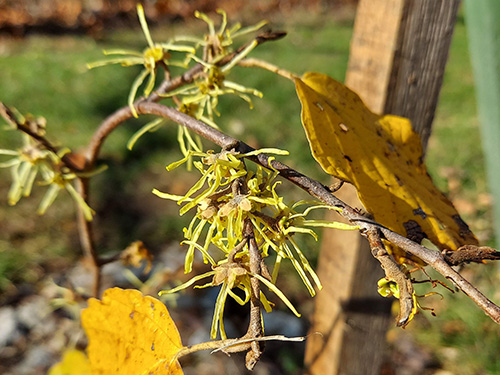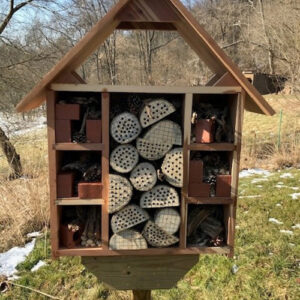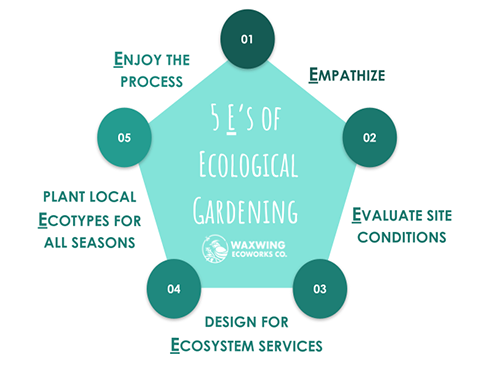As February turns the corner into March, our thoughts turn the corner into spring, and to planning our gardens! To help with the planning process, we asked some of Lancaster’s native gardening experts to share their top tips for your best, most vibrant, and most pollinator and native species friendly garden ever!
Rebecca Lauver, PA Forests Projects Coordinator, Alliance for the Chesapeake Bay

American witch-hazel (Hamamelis virginiana) Photo: Rebecca Lauver
Planting native shrubs into your backyard or landscaping is an easy way to provide season-long blooms, shelter for wildlife, and a native food source for wildlife. Incorporating a mixture of woody and herbaceous plants can provide more diverse ecological functions while also creating a more dynamic and visually appealing landscape. Spicebush (Lindera benzoin) and American witch-hazel (Hamamelis virginiana) are shade tolerant shrubs that have delicate yellow flowers which bloom in the early spring and late fall, respectively. Wetter areas are perfect for species like silky dogwood (Cornus amomum), elderberry (Sambucus canadensis), ninebark (Physocarpus opulifolius), winterberry holly (Ilex verticillata), and our native viburnum species (Viburnum dentatum, V. lentago, V. opulus, and V. prunifolium). If you have drier soil and a bit more room, Washington hawthorn (Crataegus phaenopyrum) or American hazelnut (Corylus americana) are great choices.
www.allianceforthebay.org/

A bee hotel constructed and installed at Climbers Run Nature Preserve by Mal Gardner, for her Girl Scout Gold Award project. Photo: Keith Williams
Keith Williams, Naturalist and Community Engagement Coordinator, Lancaster Conservancy
Looking to help pollinators? Most of our native bees are solitary nesters. They often use gaps and cavities in dead wood or dig nests into the ground. An easy way to help them out is to provide nesting habitat. Leave a few pieces of larger downed limbs on the ground for them to use. Keep a patch of soil bare so that ground nesters can burrow in. Commerically available “bee hotels” are an option but use them with caution. Since these attract and concentrate solitary nesting bees in one place, they can be more susceptible to parasitism and disease. Poorly constructed hotels with no roof to protect them from rain will get wet and allow mold to grow. The key to a successful “bee hotel” is monitoring and maintenance after the hotel is installed.
Linda Ferich, Community Wildlife Habitat Program Coordinator
Two simple practices can help transform your native garden into a vital overwintering habitat for many insects and birds. One is to move the fallen leaves from your property onto your garden beds and let them be. Many insects winter and lay eggs in leaf litter, and it is also a free and nutritious mulch for your garden. The other practice is to allow hollow and pithy-stemmed plants to remain standing throughout the winter so birds can eat the seed pods. Then in spring, cut back the stalks below the seed heads (from 8 to 24 inches from the ground) to allow pollinators to deposit eggs in the hollow segments. The plant’s new growth will hide the cut-off stalks while they decompose, and the cycle repeats for another year. Here is a great diagram illustrating how to help stem nesting bees.
www.lancasterconservancy.org/engaging-our-community/habitat/
Elyse Jurgen, Owner/Founder, Waxwing EcoWorks Co.

Image: Elyse Jurgen
Waxwing’s Ecological Gardening process helps to guide your mindful action in building native habitat in a simple 5 E’s framework. Whether you are a novice or master native gardener, the following steps are key in rebuilding biodiversity:
1. EMPATHIZE with clients of the space (bees, butterflies, salamanders, grandchildren, your personal needs, etc.)
2. EVALUATE Site Conditions (hydrology, human circulation, existing vegetation, sun/shade analysis, soil, etc.)
3. Design for ECOSYSTEM SERVICES (regulating, cultural, provisioning, and supporting)
4. Plant Local ECOTYPES for All Seasons (emphasis on selecting plants that are adapted to our ecoregion)
5. ENJOY the Process! (habitat building is all about the journey, not the destination)
To learn more, view Elyse’s Nature Hour presentation.
www.waxwingecoworks.com/
Looking for more resources on how to create your best native species garden? Our Community Wildlife Habitat page has a number of additional resources, including contractors to get you started, a sample rain garden layout, native plant lists and source lists, and a list of common invasives to yank out or avoid.
Header image: Michelle Johnsen
